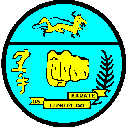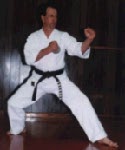Send all comments to LF Dodson
 Karate utilizes both the physical and the psychological aspects of a person's makeup.
Karate utilizes both the physical and the psychological aspects of a person's makeup.
If we compare the body to an automobile, we can illustrate this concept. An automobile is a machine. Its mechanical components must be present and it must have periodic maintenance (tune-ups) in order to function efficiently. This would be the physical aspect.
However, no matter how new the parts or well tuned the engine is, if there is no fuel or the wrong fuel, the machine will either not operate at all, or will not operate at peak efficiency. This could be correlated to the psychological aspects of karate.
The psychological aspect is what motivates and the physical is what activates the marvelous machine known as the human body.

The physical aspects of karate can be broken down into speed and power, muscle co-ordination, focus, control, kiai, response, and conditioning. We will define each of these and how we apply it to the study of karate in the following sections.
Another basic form of power is "reaction-force". For every action there is an opposite and equal reaction. This law of physics is demonstrated when we execute a right reverse punch. Our left hand is retracted in the opposite direction in order to generate power.
In coordination, the hip and shoulder muscles should move first. They are stronger but function slower. The hand and foot muscles, faster but weaker, should come into play last. The strike is more effective if the extremities are completely relaxed until just prior to contact.
You should also realize that when breath is inhaled, the body becomes weaker. If a person is struck with full lungs, the strike will more than double its damage. With this in mind, you should try to strike when your opponent's lungs are expanded. If noise acccompanies the kiai, usually an opponent or adversary will inhale due to fear caused by the element of surprise.
Your kiai should begin with the contraction of the lower stomach muscles and progress upwards. Simultaneously the lung muscles should contract, abruptly forcing the breath out through the mouth in one burst. You should then inhale immediately (through the nose) to admit oxygen for the body.
This is accomplished by setting up situations during practice and reacting with the same technique over and over. Response time can be honed to a point where it seems mystical to the novice.
The main objective is the development of the bone tissue and the hardening of surface skin tissue. After tearing down these tissues, be sure to allow ample time for the body to revive itself or your objective is defeated.
The psychological aspects of karate that must not be overlooked are attitude, confidence, concentration, and meditation. For a brief description of how we apply these concepts to karate, see below.
A physical confrontation is a no-win situation, whether you "win" or "lose". Once a student has attained a certain level he becomes aware of his physical capabilities. This knowledge will usually govern his decision-making. A true karate-ka will try to avoid any situation which might lead to a physical encounter. This is done by not patronizing establishments where trouble can be found or setting conditions which might cause it to come to him.
However, if you find yourself in an unavoidable situation, an exhibition of self-confidence may stop the aggressor. More often than not, a karate-ka can avoid an active situation by merely walking away. If his attitude is properly balanced, he can do so without the loss of self-esteem. From training, he knows his capabilities and does not have to prove anything to himself or anyone else.
If a situation is definitely unavoidable you must defend yourself. While trying to avoid a situation, do not allow yourself to be caught unprepared or unable to defend yourself on your own terms (i.e. do not let yourself get backed into a position that cannot be adequately defended). Under actual fighting conditions you should try to remain as calm as possible. Be in a state of constant observation; do not focus your concentration on any one person or place. Always be aware that an attack could come from any direction.
If you have any doubts, find out if they are because of the technique or if it is doubting your ability to properly execute. If it is because the technique does not suit you personally, omit it. If the problem is within yourself study the aspects of Confidence and Meditation for a deeper understanding.
The presence of self-confidence will usually cause an adversary to think twice. This is also true in your everyday life. Always exhibit a positive attitude - a positive attitude will build confidence and eliminate the fear of being hurt.
Lack of confidence can infect and undermine your ability to concentrate. These undesirable thoughts can be eliminated through use of meditation. Use meditative techniques to develop an understanding of why you think this way; then work to overcome this self-doubt.
The body's physical condition can also work against complete concentration. Be sure your physical needs are satisfied (i.e hunger). Once you are at ease both physically and mentally, complete concentration can be attained.
To meditate a student must weigh and consider his thoughts; weigh their importance, and consider their benefits vs. their detriments. If a thought is wrong, it must be omitted. Visualize yourself attaining your goals and utilize Reasoning.
Reasoning is an aspect of Meditation. Reasoning is the employing of rational thinking to conceive the most suitable and desired thought and then to repeat this new thought to the conscious mind until the subconscious adopts it, and substitutes it for the undesired thought pattern.
Send all comments to LF Dodson